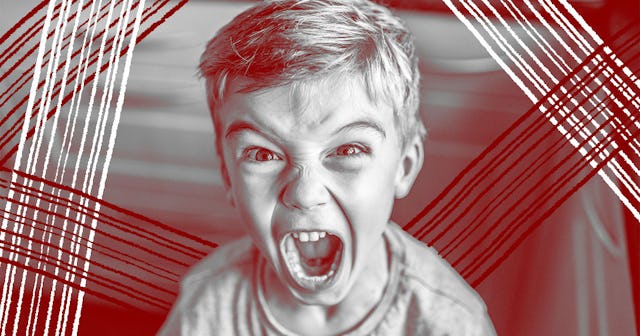Rage Is My Son's Default Emotion -- And It's Worse Now Than Ever

When my husband became too sick to parent, when he was admitted to hospice and never regained consciousness in order to tell his children goodbye, my son raged. Anything would set him off.
He was hitting his sister and screaming at me and raging at iPad games that took too long to load or glitched or did the things technology tends to do when you’re already at the breaking point of patience.
And after my husband’s funeral, my son sat in a grief therapist’s office and she asked him to draw where his feelings lived in his body. His sadness was in his belly—and it explained, at least to me, why he’d been vomiting every night since his father had died. His anger was in his hands. In the hands he used to hit and pound and throw.
His awareness astounded me. Even now, I’m not sure I could so easily identify where feelings live in my body—but he did, managing to link the physical with the emotional in a way that stuns me even three years later.
Day by day, his anger waned. He learned to channel that rage—to come running to me and squeeze me in a hug as hard as he could to get that anger out of his hands before it landed on his sister. To take a few extra breaths before he began screaming so loud he’d become breathless. To learn to say “I’m scared” or “I’m frustrated” when that was behind the eruption of emotion.
Against the backdrop of a pandemic that’s rolling into summer, when things remain far from normal and scary and so far out of his control, his anger refuses to wane. Instead, it crests all too often, masking the fear and anxiety and frustration…and yes, even the anger is masked by anger.
He’s terrified. One day he was in school, surrounded by his friends and teachers, and the next he is home…all the time. Because a virus, an invisible threat, is circulating through our neighborhood, choosing victims seemingly at random. He knows he’s safe. I have told him kids are largely safe and I’ve kept him carefully shielded from the fact that there’s a mysterious inflammatory syndrome targeting some kids in some instances. He’s aware that staying home is not an act of fear, but an act of compassion—to help protect the virus from spreading through our community. And yet, he’s scared. He’s scared because he sees me wiping down door handles daily. And because sometimes, often times at first, I couldn’t get the things we needed from the grocery store. And because I’m the only parent he has, and he knows the worst can happen—it has before.
Mayte Torres/Getty
And when I ask him to go upstairs to put on socks, and he begins screaming that he doesn’t want to, I understand that he’s not angry at my request. He’s afraid. Afraid to go upstairs alone. Afraid I might not be here when he gets back. Afraid of the invisible things that lurk in places that once seemed so safe.
He’s anxious. The world is changing so fast, and no amount of talking about those changes will change the truth that there are elements that remain scary, that persist in being difficult to understand. Sometimes there simply aren’t words to fill in the blanks. He’s seeking comfort and clinging to his sister, to me, and forgetting—or incapable of recognizing in his current mindset—that we’re both human, we both need to reset ourselves before we can give him anymore. His anxiety won’t let him give us that space. It is too great, and he lashes out with a rage that shakes his body when we ask him for space.
He’s frustrated. Homeschool wasn’t easy, and to be perfectly honest, I’m a terrible homeschool teacher—significantly less patient than his teacher and certainly way less capable of teaching second grade math. That frustration manifests in pounding on the table and throwing his pencil. It means he’s too angry to listen when I try to explain and too impatient to learn. But it comes from a place of wanting to do well, of seeking perfection and control in a time when he has so little control.
And he’s simply angry. So so angry. Angry that there’s a scary virus. Angry that his father isn’t here while there’s a scary virus. Angry that no one knows anything about the future and that things simply aren’t normal.
Which is all to say, I can understand the underpinnings of his anger, but I nevertheless feel helpless against that same rage. At times, it feels as if he will be defined by his temper, and I don’t want rage to be the thing he takes into adulthood.
But then I remember. The pandemic is not the first time I’ve seen my son so angry. And when he’s done raging, breathing that fiery anger, when it’s just the puffs of gray smoke left in his heaving chest, I know he’ll talk about his anger—and maybe, hopefully, he’ll start to remember that, like after his father died, sometimes that anger isn’t really anger. Sometimes it’s fear or anxiety or frustration, even sometimes all three wrapped with a bow of rage.
The truth is my son is still learning how to process his emotions, which are often too big for his little body. His fear comes out as anger. His anxiety comes out as anger. His anger comes out as anger. During the pandemic, all these emotions blend together, and it’s no wonder that he’s angrier than ever.
But he’s learning and he’s working on it, and sometimes that’s all you can do.
This article was originally published on